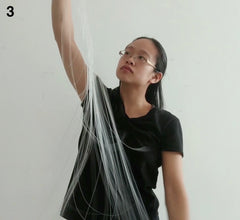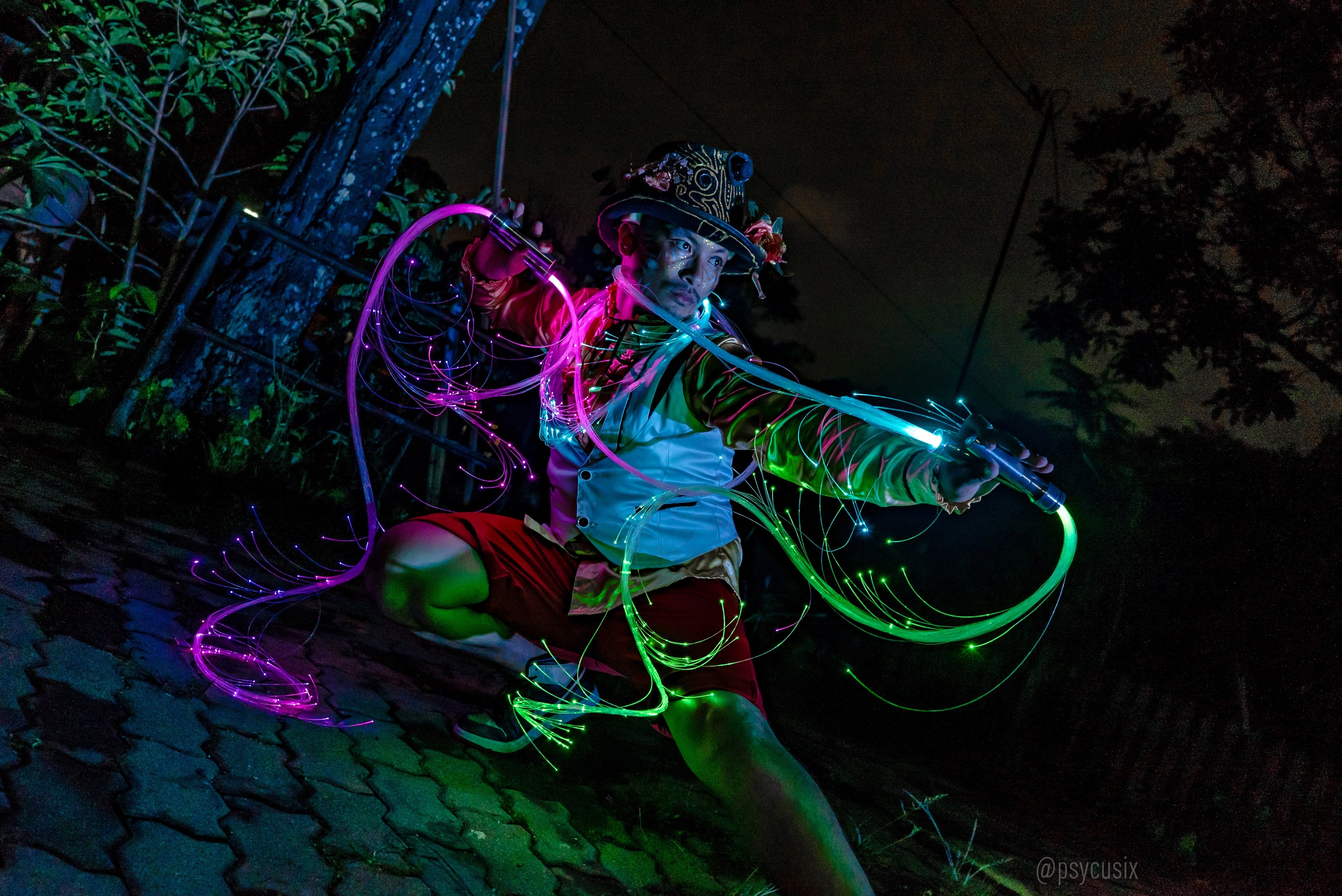Need a new FiberHead? Buy one HERE
Searching for the perfect look for your LED whip?
Maybe you want your fibers to look good for a dance performance, or perhaps you'd like to learn how to make an LED whip with spiraling fibers for an “Elsa” costume from Frozen.
Image credit: @ashleyneptune
DIY Pixelwhip: Adding Curls to Your Fibers

This DIY tutorial will show you how to reshape your pixelwhip fibers into a curly shape*, with hints on how to achieve a custom look.
By the end of this article, you’ll learn the following:
-How to fix a FiberHead with bent or deformed fibers
-How to safely heat your fibers to reshape them
-Why your fibers might look different after you store them in hot environments
*(Want to straighten your fibers, instead? Get on our email list, and we'll let you know when this tutorial is out!).
 PRO TIP: if this is the first time you've tried to reshape your fibers, use an old FiberHead. If you need another FiberHead, buy one of our replacement heads HERE.
PRO TIP: if this is the first time you've tried to reshape your fibers, use an old FiberHead. If you need another FiberHead, buy one of our replacement heads HERE.
What you’ll need:
- A pot or flat-bottomed bowl big enough to coil your fibers into (not too small, or it will be hard to get the fibers submerged). Try coiling your fibers into this pot BEFORE you add hot water to make sure it isn’t too small.
- A second pot or water kettle to boil water in. This is separate from the pot that will hold your fibers since you do NOT want your FiberHead to touch hot surfaces!
- A long wooden or plastic cooking utensil** that can span the diameter of the pot opening. You’ll be attaching your FiberHead to it.
- Gloves that can protect you from hot water splashes and steam. Rubber gloves will not protect you while holding a hot pot, but they will work ok as a barrier from small drops of hot water.
-
One or two zip ties.**
**For curling your FiberHead, the spoon and zip ties are optional unless you want to leave the fibers in the water for a longer time. We have found that straightening fibers requires a longer heating time than curling, so using a spoon and zip tie to hold the FiberHead in place instead of holding it yourself will save you a lot of time!


First, start boiling your water (using the pot/kettle that will NOT be holding the FiberHead) while you prep your fibers for heating. Make sure you boil enough water to cover the fibers. While you follow these steps, be careful to NOT to submerge the metal base of the FiberHead!).
Prepping your pixelwhip FiberHead:
-
Before you start, detangle your FiberHead, starting from the tips of the fibers and working your way up to the base of the bundle. You might want to apply a small, dime-sized amount of lubricant with a microfiber cloth to help you with the detangling process. We recommend silicone-based personal lubricant, like Swiss Navy - a water-based lube will just gum up your fibers and make them stick more.
Make sure your fiberhead doesn’t have any kinks or knots in the fibers - you wouldn’t want to preserve a pre-existing tangle in your whip (unless that’s the look you want for a costume or lighting design, of course)!


-
Then, swirl the fibers together so they form a single bunch with no stragglers. You can do this by holding the handle in one hand and forming an “O” with your other hand around the fiber bundle. Moving the whip handle in a circular motion, swirl the whip as you move the “O” hand from the base of the FiberHead, down the length of the fibers. Do this several times.




- Gently weave in any straggler fibers (avoid creating kinks in the fibers by not using too tight of a weave, and don’t make any knots). The general pattern of weaving is a long zigzag through the main bundle of the FiberHead.
- We recommend you detach your FiberHead from the pixelwhip flashlight/base lighting unit before you apply any heat to it. Place the flashlight in a safe place so it won’t get wet or fall in the water.
|
>>> Looking for an extra FiberHead to experiment on? Want multiple FiberHeads so you can switch between fibers for a different look when you flow? |
To get curly fibers, follow these steps:
-
After you boil the water, remove it from the heating element, and let it sit 45-60 seconds after it stops boiling to make sure that it isn’t too hot.
-
Pour the hot water into the first pot.
-
Wearing gloves, gently hold or swirl your fibers in the hot water for 40-50 seconds, taking care not to submerge the metal base of the FiberHead.
-
Wearing rubber gloves, remove the fiberhead from the pot and re-coil the fibers into a bundle that is small enough to fit into the FiberFlies cloth bag (or other bag of your choice). For larger coils, choose a larger bag or bowl to place the FiberHead into.

-
Leave the FiberHead in the bag, allowing the fibers to retain the coils as they cool into the shape you have left them in. Removing the FiberHead before the fibers cool may result in less coiled fibers. We recommend leaving them in for at least half an hour.

Did you know?
💫 Know-how from the experts:
You might notice if you leave your pixelwhip FiberHead in a hot room, or in your car on a hot day, it will retain whatever shape it was in as it cooled. This happens because LED whip fibers are made out of a material called PMMA, which is a thermoplastic. This means that it becomes softer as it is heated, and it hardens as it cools (you’ll notice that fibers will become brittle and shatter more easily in the cold!). To fix any unwanted bends or kinks in your fibers if you've left them in the heat by accident, just follow the steps above!
💫 *Pro DIY tips*
For unusual shapes, we have found that a damp towel that has been steamed or warmed can be placed over the fibers, weighing them down to retain whatever shape you have placed them in!
✨If you've followed the tutorial above and want to post your results, use #diyfiberform to show off your skills on social media! ✨













